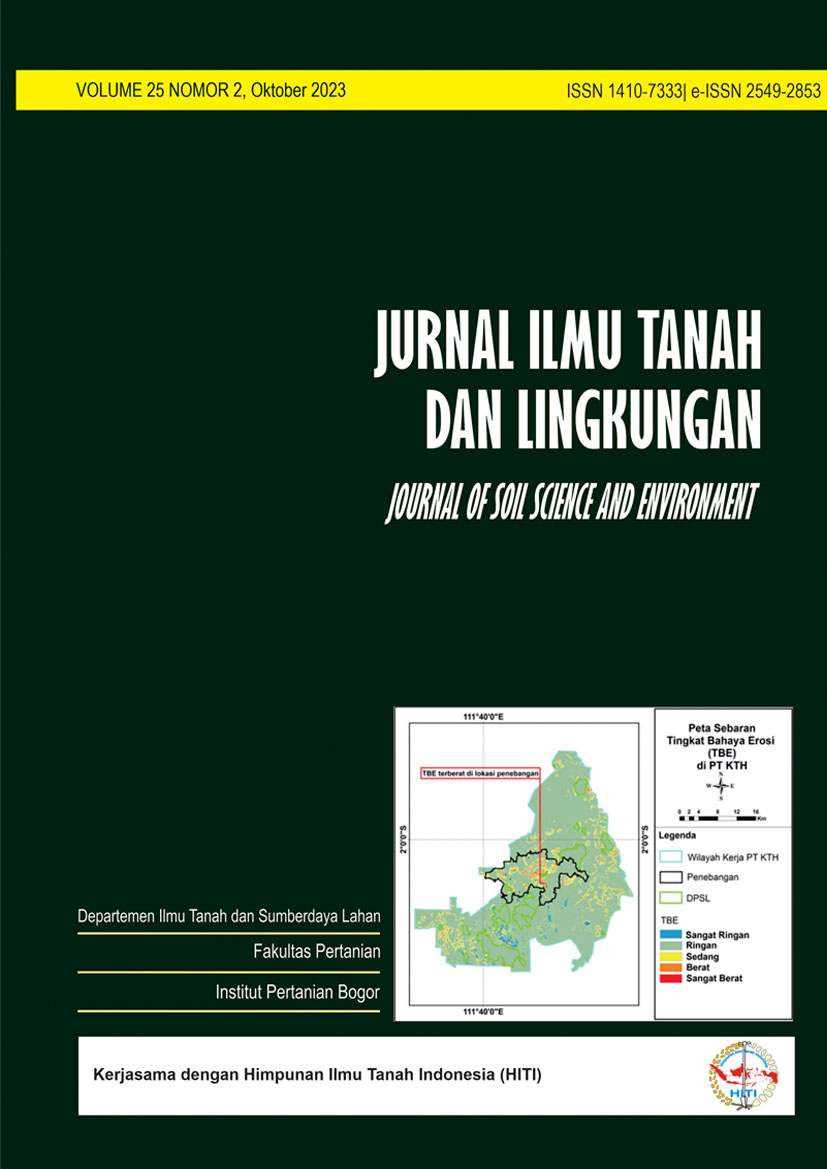Characteristic and viability of nitrogen fixation bacteria and phosphate solubilizing bacteria in carrier media
Abstract
A consortium of nitrogen-fixing bacteria and phosphate solubilizers serves as biological fertilizers to increase the availability of plant nutrients such as nitrogen (N) and phosphorus (P). The experiment aims to study the character of nitrogen-fixing bacteria and phosphate solubilizing bacteria and compare their viability on the biochar (made from husk charcoal and corn cobs) as the carrier media. The experiment involved several tests, such as pathogenicity, nitrogen-fixing ability, phosphate solubilization ability on solid Pikovskaya media, compatibility, and viability. The results showed that KPB4 isolates were pathogenic to animals or humans. Nitrogen-fixing bacteria isolates, namely KBP1, KBP2, and KBP5, had N solubility (ppm) of 54.86, 77.79, and 76.28, respectively, and had NH3 concentrations (mg/L) of 66.61, 94.46, and 92.63, respectively. BPF9 (phosphate solubilizing bacteria isolate) had a phosphate solubilization index of 1.14. Each isolate of nitrogen-fixing bacteria was compatible with BPF9. The results showed that KBP2 and KBP5 each consorted with BPF9 on corncob biochar carriers had higher bacteria populations (15.50 x 107 CFU/g) after four weeks of storage.
Keywords: nitrogen-fixing, phosphate solvent, consortium bacteria, biochar
Downloads
References
Asih PR, Surahman M, Giyanto. 2017. Isolasi rhizobakteri dan pengaruh aplikasinya dengan pupuk N-P terhadap mutu benih dan pertumbuhan bibit tetua betina jagung. J. Agron. Indonesia. 45(3):255-262.
Bailey MJ, Lilley AK, Timms-Wilson TM, Spencer-Phillips TM. 2006. Microbial Ecology of Aerial Plant Surface. United Kingdom (UK): CAB International.
Bauman R. 2007. Microbiology. With diseases by taxonomy. Edisi ke- 2. New York (USA): Pearson Ed. Publ. p 437-57.
Buxton R. 2005. Blood agar plates and hemolysis protocols. American society for microbiology.1-9.
Fraile PG, Menendez E, Rivas R. 2015. Role of bacterial biofertilizers in agriculture and foresty: a review. AIMS Bioeng. 2(3):183-205.
Ghazi AA. 2017. Potential for biochar as an alternate carrier to peat moss for the preparation of Rhizobiai bio inoculum. Microbiology Research Journal International. 18(4): 1-9.
Gonggo H, Yuni I. 2006. Peran pupuk N dan P terhadap serapan N, efisiensi N dan hasil tanaman jahe di bawah tegakan tanaman karet. Jurnal Ilmu-Ilmu Pertanian Indonesia. 8 (1): 61-68.
Hafsari AR, Pertiwi VD. 2017, Isolasi dan identifikasi kapang pelarut fosfat dari fosfat guano gua pawon. Jurnal Biota: Biologi dan Pendidikan Biologi. 10(2) : 165-166.
Hardy RWF, Holsten RD, Ackson EK, Burns RC. 1996. The acetylene-etilen assay for N2 fixation: Laboratory and field evaluation. Plant Physiology. 43: 1185-1207.
Hartono, Widada J, Kabirun S. 2009. 16s rRNA sequence analysis and amonium excretion ability of nitrogen fixing bacteria isolated from mineral acid soil. Indonesian Journal of Biotechnology. 14(22).
Hofman G, Cleemput OV. 2004. Soil and Plant Nitrogen. Paris (FR): International Fertilizer Industry.
Husna H, Budianta D, Munandar, Napoleon A. 2019. Evaluation of several biochar types as inoculant carrier for indigenous phosphate solubilizing microoorganism from acid sulphate soil. Journal of Ecological Engineering. 20(6): 1-8.
Iskandar T, Rofiatin U. 2017. Karakteristik biochar berdasarkan jenis biomassa dan para meter proses pyrolisis. Jurnal Teknik Kimia. 12(1): 28-34.
Iwata K, Yu SS, Azlan A, Omori T. 2012. Ammonia Accumulation of Novel Nitrogen-Fixing Bacteria. Biotechnology - Molecular Studies and Novel Applications for Improved Quality of Human Life. Shanghai (CN): InTech.
Jain P, Khichi DS. 2014. Phosphate solubilizing microorganism (PSM): an eco-friendly biofertilizer and pollution manager. J Dynamics Agri Res. 1(4): 23–28
Kraiser T, Gras DE, Gutierrez AG, Gonzalez B, Gutierrez RA. 2011. A holistic view of nitrogen acquisition in plants. Journal of Experimental Botany. 62(4):
1455–1466
Lehmann J, Rillig MC, Thies J, Masiello CA, Hockaday WC, Crowley D. 2011. Biochar effects on soil biota - a review. Soil Biol. Biochem. 43: 1812–1836.
Lupitasari E, Ruhimat R, Umadi SS, Arumsari LAA. 2020. Isolation and characterization of Rhizobium bacteria from various roots nodules legume crops. Di dalam: Kresnawaty I, Saptari RT, Fitriyah F, Nuemila SF, editor. Integrasi Bioteknologi Pertanian dan Perkebunan di Era Revolusi Industri 4.0. Seminar Nasional Bioteknologi; 2020 Okto 15-16. Bogor, Indonesia. Bogor: PPBI-PT Riset Perkebunan Nusantara. hlm 78-84
Rao NSS. 1994. Biofertilizer in Agricultura. New Delhi (IN): Oxford & IBH Pub.
Richardson AE, Simpson RJ. 2011. Soil microorganisms mediating phosphorus availability. Plant Physiology. 156:989-996.
Santi LP, Goenadi DH. 2010. Pemanfaatan biochar sebagai pembawa mikroba untuk pemantap agregat tanah Ultisol dari Taman Bogo-Lampung. Menara Perkebunan. 78(2):52-60
Sukmadewi DKT, Anas I, Widyastuti R, Citraresmini A. 2017. Uji Fitopatogenitas, hemolisis serta kemampuan mikroba dalam melarutkan fosfat dan kalium. J. Il. Tan. Lingk. 19(2) 68-73.
Tittabutr P, Teamthisong K, Buranabanyat B, Teaumroong N, Boonkerd N. 2012. Gamma irradiation and autoclave sterilization peat and compost as the carrier for rhizobial inoculant production. Journal of Agricultural Science. 12:59-67.
Van Elsas JD, Trevors JT, Jain D, Wolters AC, Heijnen CE, Van Overbeek LS. 1992. Survival of, and root colonization by, alginate-encapsulated Pseudomonas fluorescens cells following introduction into soil. Biology and Fertility of Soils. 14(1):14-22.
Venkadesan D, Sumathi V. 2015. Screening of lactic acid bacteria for their antibacterial activity against milk-borne pathogens. Intl J Appl Res. 1(11): 970 -973
Wick R. 2010. Tobacco hypersensitivity: the first test to screen bacteria for pathogenicity. NPDN News. 5(7): 3-4.
Copyright (c) 2023 Jurnal Ilmu Tanah dan Lingkungan

This work is licensed under a Creative Commons Attribution-ShareAlike 4.0 International License.
Department of Soil Science and Land Resources Departemen Ilmu Tanah dan Sumberdaya Lahan, Faculty of Agriculture Fakultas Pertanian, IPB University



















